7 Things You Need to Know about the New ZR1
Corvette aficionados know how big of a deal this car is. Each successive generation of ZR1 has managed to dramatically reset the bar for the brand, and the first mid-engined ZR1 follows suit, debuting a pair of turbochargers straight from the factory and posting a monster horsepower figure.
Outfits outside Chevrolet have added turbos under the Plastic Fantastic’s hood, and to great success—you probably know about Callaway, the Connecticut shop that worked so closely with Chevrolet that GM extended an RPO code (B2K) and a factory warranty to fourth-gen Corvettes that Calloway had modified with its twin-turbo kit. Nearly 40 years on, Chevy has embraced the tech in-house, this time supported by everything it has learned during the development of the eighth-generation Corvette.
In 2020, we met the first mid-engine Corvette. About a year later, we met the track-honed Z06, and in early 2023, the hybrid E-Ray. Now, we meet the new King of the Hill: The first mid-engined ZR1, and the first Corvette with a horsepower figure that reaches into four digits.
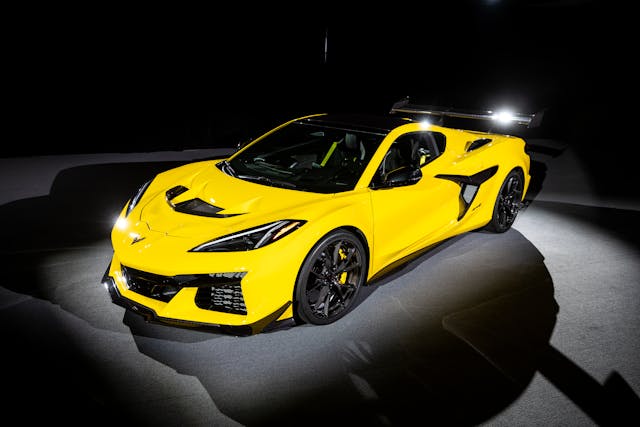
Besides the car’s outrageous power figures—1064 horsepower and 828 lb-ft of torque, on pump gas, no less!—here are the other facts and figures you need to know about the new ZR1.
Gemini: Fraternal Twins, Not Identical Ones
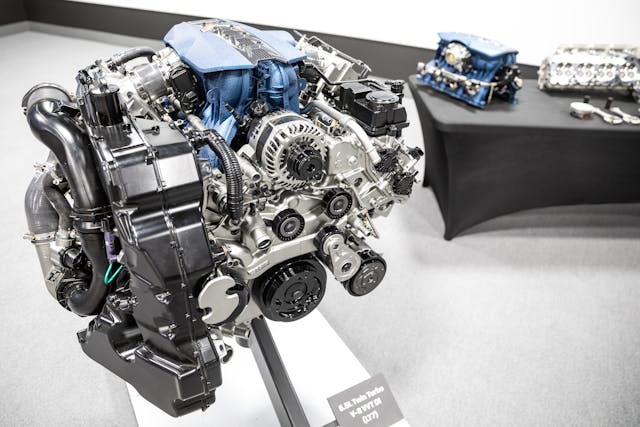
The press release takes pains to point out that Chevrolet’s engineers didn’t bolt two turbos onto the flat-plane-crank engine from the Z06 and call it a day; eight years ago, when they began to develop this flat-plane-crank V-8, they planned for a naturally aspirated variant as well as for a turbocharged one. To emphasize the close yet distinct relationship of these engines, their codes differ by just one number: LT6 and LT7.
In fact, the program umbrella for the two engines is known internally as the Small Block Gemini architecture, referencing the Latin name of a pair of twins from Greek mythology, Castor and Pollux. If you’ve ever gotten up close and personal with the engine of the new Z06, you’ll quickly understand the reference to twos—the double overhead camshafts and the pair of intake plenums. If you looked even closer, you might have spotted little rocket insignias, a nod to the Gemini NASA spaceflight program from the 1960s, and to astronauts’ love for early Corvettes.

Distinct features of the LT7 include head castings with different port architecture and larger combustion chambers, plus valvetrain, pistons, and connecting rods optimized for the added heat and power delivery associated with turbocharging. Anti-lag calibration is incorporated into the engine’s tuning to keep the engine in boost as needed. Backing up the LT7, the eight-speed dual-clutch transmission has been beefed up with shot-peened gears, higher clutch clamping load, input shaft, and oiling improvements, and a revised final drive ratio.
If you want to know more about what makes the LT7 so special, check out this article from our editor-in-chief, Larry Webster, where he dives into the juicy technical details.
LT7 Is the Most Powerful V-8 America Has Built for a Car

When the Z06 debuted two years ago, its 670-hp output made it the most powerful naturally aspirated V-8 ever built. Back then, a cross-town rival, the Ford Mustang Shelby GT500, made 90 more power thanks to a 2.65-liter Eaton supercharger. Last year, Dodge squeezed 1025 hp out of its supercharged Hemi for the Demon 170. Now, GM has the upper hand—the 5.5-liter, twin-turbocharged, DOHC V-8 in the new ZR1 makes one thousand and sixty four horsepower, and you don’t even have to feed it E85, an ethanol blend that enables more power.
When you’re bench racing with your friends, know that the “America” qualification is necessary: The wonderfully crazy Swedes over at Koenigsegg have already squeezed 1280 hp out of their 5.1-liter, twin-turbo V-8. For the sake of fair comparison, that’s the output on pump gas; on E85, it makes 1603 hp.
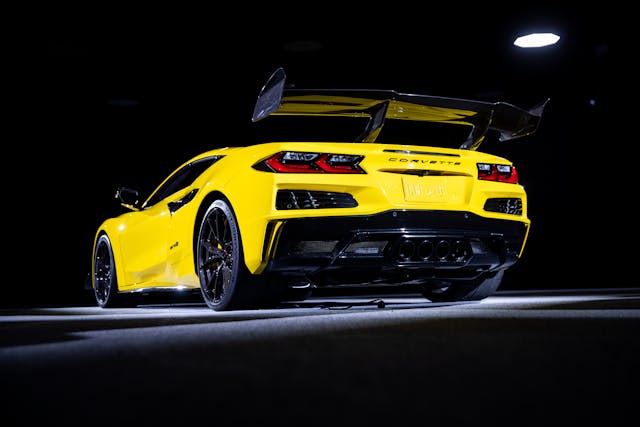
The Hood Works Hard

For several generations, one of the easiest ways to tell a ZR1 from a Z06, or any other Vette, is by the hood. On the 2025 car, the hood has neither a peek-through panel nor a giant bulge, but a cutout. Air flows into the front grille, through the heat exchanger, and back out through three passages. Not only does the “flow-through” hood design lower charge air temperatures, but it also increases downforce on the front of the car.
The Split Window Is Back … Sorta

When Bill Mitchell decided to split the back window of the 1963 Corvette with a spine connecting the hood and the rear deck, customers (as well as none other than Zora Arkus-Duntov) yowled about the compromised rear visibility. Over 60 years later, those Split Window coupes are some of the most valuable examples of the Corvette breed. (Collector markets can be funny that way.) For 2025, Chevy has brought back the split window—and this time, it’s functional. As on the Corvette race car, the Z06 GT3.R, the spine is actually a stack of carbon-fiber vents, which helps pull heat from the engine.

Yes, we’re going to pick nits here: While the serrated outlets look totally cool, and have earned their place as functional elements, they aren’t really a direct successor to Mitchell’s original design cue. His was just that—a non-functional bit of flair. (Some people even cut it out of their cars!) This is a hard-working piece of kit that, yes, will block the view out of the (already small) rear window. But since all 2024-up Corvettes now come standard with a rear-facing camera that projects its feed onto the rearview “mirror,” consider this problem solved. The engine is happier, and your field of view is wider than ever before.
The New ZR1 Draws Heavily from the Z06 Catalog

The Corvette team has already invested years of time into developing and sourcing wheel, tire, and brake packages for the other high performance models in the lineup, and the ZR1 benefits from that work. While there will be some unique wheel designs, the diameters are the same as on the Z06: 20 and 21 inches, front and rear. The section width of the tires is the same, too—275 front, 345 rear. Like the Z06, the ZR1 is delivered on a set of Michelin Pilot Sport 4S tires (the summer rubber option on the E-Ray), unless you upgrade to the track-oriented performance package. On the ZR1, that package is a holistic set of aero, tire, and suspension changes dubbed ZTK. It adds a far more aggressive Michelin, the Cup 2 R.
Chevy says that the brake system on the ZR1 is new, and includes “the largest front rotors ever equipped on Corvette,” but the carbon-ceramic rotors on the ZR1 are identical in diameter to the optional carbon-ceramics on the Z06 (these also come standard on the E-Ray). The numbers: 15.7 inches in front, 15.4 in rear. We’ve reached out to Chevy to clarify the differences between the systems.
Regardless, Chevy has clearly done its homework when it comes to appropriate stopping power: In just 24.5 seconds, reads the release, the new ZR1 can accelerate from 80 to 200 mph and brake down to 80. That’s 22 percent quicker than the C7 ZR1, and 53 percent quicker than the C6 ZR1.
It Makes a Lot of Downforce



The performance-oriented ZTK package makes a real and significant difference in how the car will behave on track. Let’s unpack what it includes: Aero elements include a fixed rear wing on the back deck, front dive planes, “a tall hood Gurney lip,” and underbody strakes. Those of you who have been reading our spy-shot stories will recognize this kit immediately. All of those bits are made of woven carbon fiber, and they are complemented by the rest of the ZTK package, which adds stiffer springs, retunes the standard Magneride dampers, and swaps the PS4S tires for Cup 2 Rs. (You can also add just the aero kit via the Carbon Aero package.) Total downforce generated by this concert of aerodynamic upgrades is a whopping 1200 pounds. Pity the tires!
It’s a 200-MPH Car, Easy
After putting together the immense power of the drivetrain, the stability of the aero kit, and the huge brakes, it’s no surprise that the ZR1 can hit 200 mph, and with ease. All four test drivers hit 200 on the Nürburgring—on their very first laps, says Chevy. There isn’t a whole lot of pure straight on the ‘Ring, but there is a 2 km (1.2 mile) stretch that is very nearly turn-less. If the ZR1 were turned free on, say, a certain runway in Florida or stretch of highway in Texas, who knows how much faster it might go? We bet Chevy does—but the press release merely states a top speed of “over” 215 mph.
Blue Is Back
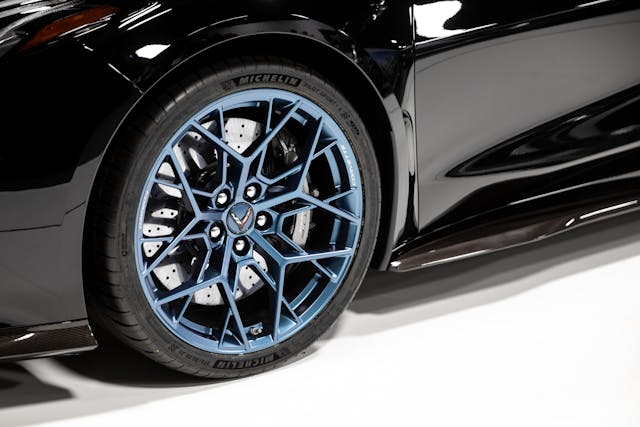
We’d be remiss if we overlooked the aesthetic changes that make the ZR1 feel special from the very first glance. There is a host of available parts and paint colors that are shared across the existing lineup, like a carbon-fiber roof and Sebring Orange paint, but Chevy made sure that the ZR1 got some bling all its own. Blue has been the ZR1 accent color ever since the sixth generation of the Corvette, when Chevy first added a supercharger to create the “Blue Devil—” the nickname for the C6 ZR1 and the first production Vette to clear 200 mph. The LT7’s intake is finished in Edge Blue, and you can order your C8 ZR1 with blue interior stitching, blue wheels, even blue brake calipers, an option that won’t be available on any other C8.
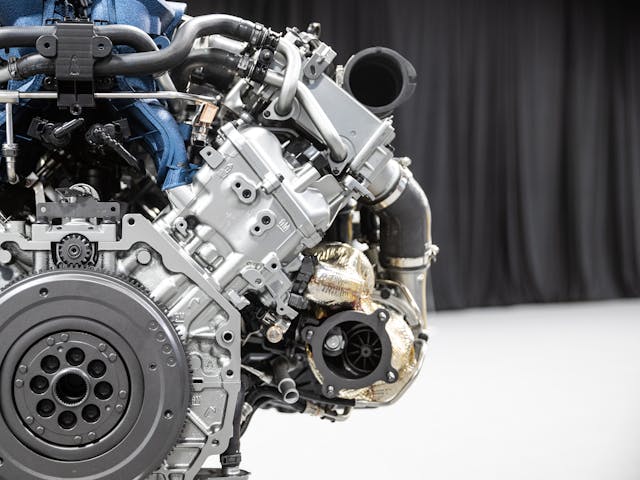



These cars should come with training for the owners, much the way Ford does with several of its products. Most future owners lack the skills to handle this kind of power. Let’s hope we don’t see a YouTube video two days after deliveries begin with the classic power burnout into a tree/pole straight out of the dealership parking lot.
Buyers of new Corvettes receive a voucher that allows them to attend the “Corvette Owners School” at Spring Mountain Motor Club in Nevada, for a discounted price of $1000. The Corvette Owners School is a two day high performance driving program using Sting Rays and Z06’s, put on by the Ron Fellows Performance Driving School in association with Chevrolet. I’m sure the upcoming ZR1 will continue to offer this program, likely using ZR1’s.
How much$?
you remember what Howard Huges said?
If you have to ask how much you cant afford it
That quote is attributed to J.P. Morgan when asked how much it costs to maintain his yacht, “Corsair”.
All they need to do is to add a manual transmission to make it a real car.
Cars like this are so far beyond 20th C drivetrain tech that the only accomplishment a stick could acheive is to make them slower.
The point of having a stick is not a matter of straight line acceleration, that is but one measure of a sports/enthusiast car. In my opinion, a manual offers greater control of the driveline and an overall better driving experience. For that matter, I would also suggest the stability management system have the option to be turned off…
BTW, I seriously doubt this car is slow no matter the choice of transmission
Frank, not slow, but slower. Still, crazy fast. “a manual offers greater control of the driveline” – used to be, but dgt’s are just quicker and their choice of gear is less often wrong that a three-peddler’s. Massively capable cars are better with (and for) them. Yes, a manual is a different driving experience, but not imho in this kind of super performer.
Stability management and traction control can be turned off – even in the Stingrays. It’s just a matter of pulling up the touch screen display menu. There are a lot of adjustments you can make there including shock controls and ride quality. 6 different parameters can be customized.
Exactly. 3 months ago I sold my 4 speed 1979 Corvette that I’ve owned since new. In 1987 I changed it to a Doug Nash close ratio manual and swapped out the 3.70 gears for 3.08s. That was the best mod I ever did to that car. Better off the line. Higher top speed. Better highway cruising. Better mpgs and range. I enjoyed using the manuals when I drove on the mountains and twisty roads of NJ. But now I live in Florida where it’s all straight, right turn, straight, left turn, straight, straight, straight… Shifting a manual here is nothing but senseless, extra work. So I sold that car and bought a 2024 Stingray with it’s 8 speed automatic. Much better. So I’d say it depends on where you live.
Bob, to your straight description of FL roads, you can add flat, crowded & patrolled. I agree with your change of cars.
Ah, the ’79. Good for you hanging on to it for so long. 3.70 gears! Did it have an L82? Otherwise, that’s a pretty modest level of engine performance? Nice cars though
Lots of cool things on this car. Should be amazing when we see it next year.
Would make a nice first car for a high school kid . ( if you can’t tell that’s sarcasm )
Doubt that will happen very often.
If you have ever seen the cut-away of the C8 Corvette transaxle you would immediately think you are looking at a manual transmission. Huge gears and shift forks, all being managed electronically and seamlessly due to the dual clutch set up. No automatic transmission uses this type of gear set. Automatics use sun and planetary gears along with bands to provide gear ratios. And torque converters that the C8 does not have. This is all due to packaging the transaxle and provide the beef all the different C8 engines provide. Google the cutaway view of the C8 transaxle. If you are a gear head you will be impressed.
Your right I along with 88% of Americans can not afford this car. I have a 598 hp crossfire, SL55 motor , can’t let anyone drive it because most people think they can drive but just under 600hp with a 3200 lb car NO.
as for the corvette I have less than $20,000.00 in it. now that is cost that i can live with. jim
Oh, yes i do things others can”t, example 2003 PT Cruiser ran12.50@ 116
Finally a Corvette I can’t wait to drive/ own…
Plastic fantastic? still a plastic pig as far as I am concerned!
Plastic toy.
Cmon!
If you like gaudy, go for it. I will keep my C2 thank you.
Yeah, there’s nothing like having a strong, efficient engine, good mpgs, excellent crash protection, tight power steering, power brakes, cruise control, good A/C, good radio, good tires, no squeaks and rattles and a smart, adjustable suspension that can absorb most pavement imperfections without a care or hit the track and go around corners well…
And a C2 is nothing like it… (don’t blame me, you brought it up)
I’m surprised that envious nit pickers haven’t complained about the interior on this thread yet. That’s what most do when they come upon an exceptional American product that outperforms the competition – at a much lower price. When I go somewhere in my car, I don’t spend very much time parked – nitpicking the interior. It’s about DRIVING.
It is a hard habit to break. Corvette interiors were pretty weak until C7, and finally hit their stride with C8 even with the square steering wheel.
Can someone explain how these engines get so much more horsepower on E85 gas vs say high octane?? It’s mentioned but not explained ?? Is E85 oxygenated? does the ecm add more air for less fuel potency? It doesn’t make sense to me..
Google is your friend here. E85 is a type of fuel that contains 85% ethanol and 15% gasoline12345. It has an octane rating between 100 and 105, making it higher octane than regular gasoline